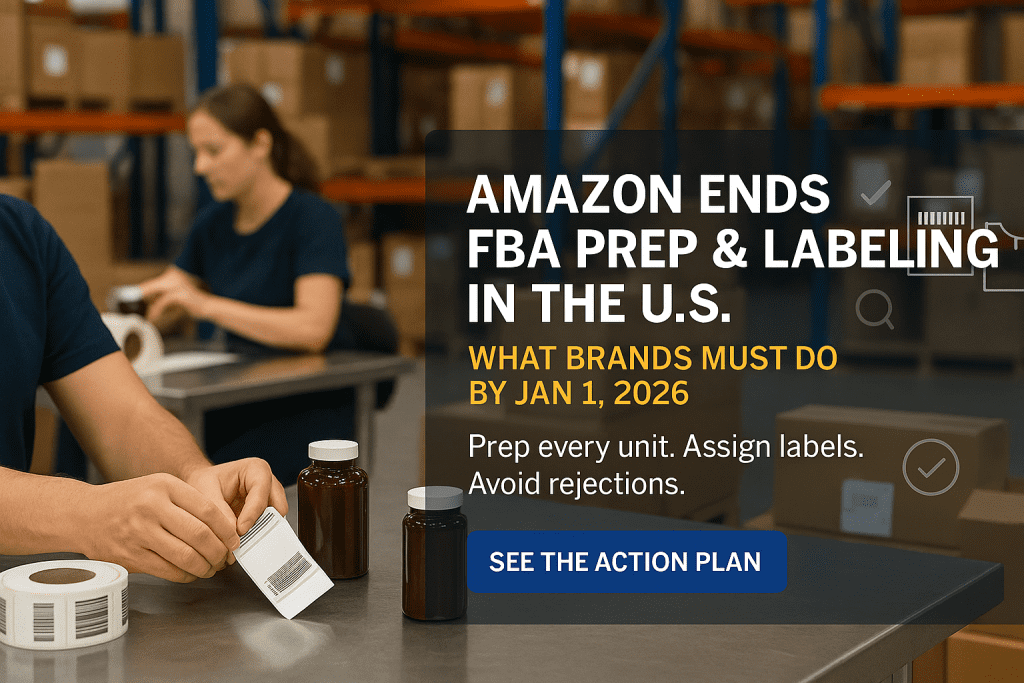Author: Jason Martin
Reviewed by: Senior 3PL Implementation Lead
Last updated: September 27, 2025
Executive TLDR
Amazon will stop doing U.S. FBA prep and labeling after January 1, 2026, so your units must arrive ready to receive.
Lock a clean FNSKU map, clear prep rules, and carton or pallet label standards now.
Stand up a compliant prep flow with lot and expiry capture, FEFO pick rules, and photo proof.
Run a pilot, ship top movers first, then scale to the full catalog.
Use a central U.S. 3PL to hit 1 to 3 day ground zones and protect margin with right sized packaging.
Need to make your inbound Amazon ready, fast — Contact Product Fulfillment Solutions
Table of contents
What the change means
What must be prepped and labeled
Your 30 day compliance plan
Quality controls for dated or regulated items
Costs to expect and how to reduce them
Why Product Fulfillment Solutions
FAQ
What the change means
Starting January 1, 2026, Amazon will no longer do U.S. based FBA prep or unit labeling for you. Inbound that is missing labels or required prep will be rejected, reworked at added cost, or disposed. The fix is simple. Your units need to arrive compliant, with the right barcode, packaging, and carton or pallet identifiers that match your shipment plan.
What must be prepped and labeled
Every inbound must match your shipment plan details and meet item level rules. The common items on the checklist:
FNSKU or scannable barcode on every sellable unit, one code per SKU, clean placement, high contrast.
Prep by product type, poly bag, bubble, boxed, set marking, suffocation warnings, tape rules.
Carton content accuracy, cartons list the right SKUs and quantities, no mixed contents unless allowed.
Carton or pallet labels that match the shipment plan identifiers, readable and placed where scanners can see them.
Expiration date and lot, displayed as required for ingestible or regulated goods, captured in receiving data.
If this already sounds like a lot, hand the workflow to PFS and keep selling.
Your 30 day compliance plan
Week 1, lock the data
Create a clean map for SKU to FNSKU or UPC, product title, unit of measure, case and inner details, weight and dimensions, shelf life, lot or expiry rules. Decide prep by family, for example, liquid supplements in poly bags with suffocation warning, cosmetics in bubble sleeves, small electronics boxed with lithium ion, warning, labels, if required.
Week 2, label and packaging setup
Generate and test labels, unit barcodes, sold as set or multi pack labels, carton labels, pallet labels. Build a packaging matrix, which box or bag to use by product family to reduce damage and DIM weight. Photograph each finished unit and a finished carton for proof.
Week 3, pilot inbound
Pick the top movers and send a small, clean shipment that mirrors the full process. Include accurate carton contents and booked dock time. Measure dock to stock, mislabel count, and damage.
Week 4, scale and standardize
Roll the process to the rest of the catalog. Add simple SOPs, a one page receiving checklist, label placement templates, and an exception lane for relabel or rebag. Post the latest SOPs near the prep bench and in your WMS.
If you want the fastest path, stand this up with our 3PL fulfillment and ecommerce fulfillment, then plug in Product Fulfillment Solutions as volume grows.
Quality controls for dated or regulated items
Capture lot, batch, and expiry at receiving. Apply unit labels that show the correct date format where required.
Enforce FEFO picking, so the earliest expiry moves first.
Use a second scan at pack for high risk items to prevent swaps between similar SKUs.
Keep a small daily audit, five to ten bins, to catch drift early.
Store inserts, warnings, and retail stickers at the prep bench to avoid misses.
You can formalize this through warehousing and storage solutions and connect retailers with EDI solutions and connections when wholesale ramps.
Costs to expect and how to reduce them
Labeling and prep labor. Cut touches by standardizing label placement and using batch print or scan to print.
Packaging and materials. Build a box or bag matrix that right sizes by family to lower DIM.
Rework or refusal. Clean data and photo proof reduce back and forth. Pilot shipments catch misses before peak.
Freight and split shipments. Use a central U.S. hub to hit 1 to 3 day ground zones and combine shipments. See discounted shipping rates for options.
Why Product Fulfillment Solutions?
Amazon ready FBA prep at scale, clean labeling, correct packaging, and shipment plan alignment.
FEFO with lot and expiry at receiving for supplements, vitamins, and other consumables.
Dock to stock speed, barcode first receiving that matches carton contents and labels.
Central U.S. location in Cincinnati for fast ground coverage to most customers.
Kitting and light assembly for sets, promos, and subscription boxes.
Live visibility into inbound, inventory, and orders via real-time information.
FAQ
What happens to non-compliant inbound after January 1, 2026
It can be rejected, reworked at added cost, or disposed. The safe path is to label and prep units before they ship.
Do I have to convert UPC to FNSKU
You need one scannable code per sellable unit that Amazon will accept for your listing. Most brands map each SKU to a single barcode and keep placement consistent.
Can I send mixed cartons
Follow your shipment plan. If mixed cartons are not allowed for a lane, do not mix. Accurate carton contents speed receiving.
How do I handle expiry dates
Print or apply labels in the accepted format, keep dates readable, and capture the values in receiving so FEFO works.
What is the fastest way to get compliant
Run a pilot with top movers using our FBA prep services, then scale. You can be shipping clean in weeks, not months.

